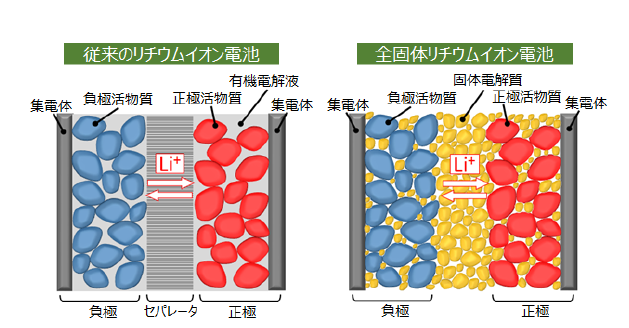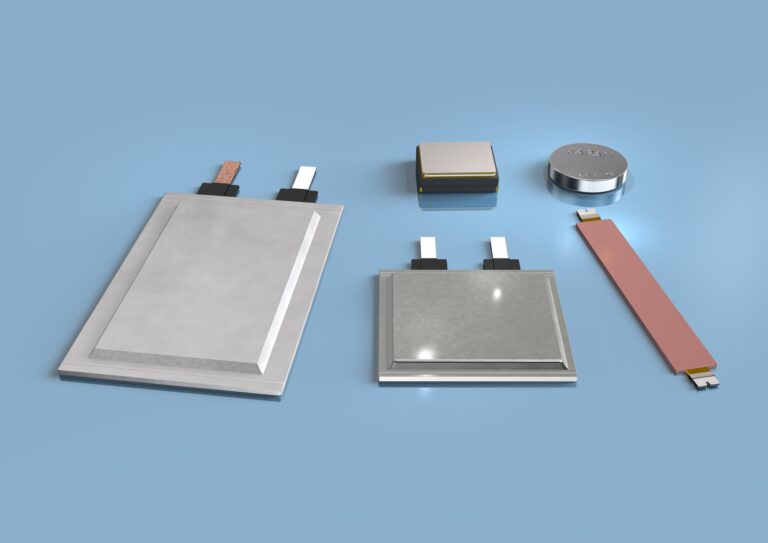Expectations for All-Solid-State Batteries
All-solid-state batteries are attracting attention as next-generation batteries that replace the liquid electrolyte of lithium-ion batteries with a solid electrolyte.
Replacing current liquid-based lithium-ion batteries with all-solid-state batteries is expected to ensure a high level of safety, higher energy density, a wide operating temperature range, and longer service life.
It is believed to have great potential, especially in the areas of electric vehicles (EVs) and renewable energy storage.
However, several technical and economic issues remain to be solved, and their resolution is key to practical application.

Source: IEEJ
Timeline for practical application
Many companies and research institutes are currently working on the development of all-solid-state batteries, with commercialization expected in the late 2020s and early 2030s.
Some companies have announced plans to begin mass production around 2028, with the goal of bringing high-performance, competitive products to market.
However, further cost reductions and improved reliability are needed to achieve broad market penetration.
| Manufacturer | plan | authority |
| Toyota | Challenge to commercialize in 2027-2028 | TOYOTA Official HP |
| Honda | Pilot line to be unveiled in December 2024, operation to start in January 2025 ・Aiming to start mass production in the late 2020s | Honda’s official HP |
| Nissan (Japanese car company) | ・Pilot production line to be unveiled in April 2024 ・Aim to bring to market by FY2028 | Nissan Official HP |
Main issues to be resolved
1. material issues
The performance and stability of all-solid-state batteries are highly dependent on the solid electrolyte and electrode materials used.
Active material (electrode material) selection:.
In the press, it is often said that “all-solid-state batteries = high energy density,” but the reality is not that simple.
High energy density can be achieved on the assumption that the solid electrolyte is nonflammable, so highly active materials that could not be used in conventional liquid batteries can be used safely.
For the cathode material, the conventional NCM 1 and NCA 2 for the cathode material and metallic lithium instead of carbon for the negative electrode are being considered, but there are still many challenges to be overcome.
Solid Electrolyte Selection:.
Materials with high ionic conductivity but also chemical and mechanical stability are needed.
Sulfide, oxide, and polymer materials have been studied, but each has its own challenges.
Currently, sulfide systems appear to be a step ahead, but they have the problem of generating highly poisonous hydrogen sulfide when in contact with moisture.
Solving this issue is essential for practical application in vehicle applications.
Interface problem with electrode:.
Resistance and reactions that occur at the interface between the solid electrolyte and lithium metal or other electrode materials can cause a reduction in overall performance.
To solve this problem, interface design and the development of new materials are required.
Recently, it has been reported that soft sulfide-based solid electrolytes can solve these problems.
2. manufacturing process issues
It requires a different process than current lithium-ion batteries, and there is an urgent need to establish technology for mass production.
Specifically, there are processes that require an extremely dry environment and that must be pressed under high pressure.
The need for a dry environment is also due to the fact that hydrogen sulfide is generated by sulfide-based solid electrolytes, so if the hydrogen sulfide problem can be solved, an extremely dry environment will no longer be necessary.
- Scalability: Requires high-precision manufacturing techniques, which tend to be more expensive.
- Homogeneity: Lack of technology to ensure uniform quality during mass production.
3. cost issues
The manufacturing cost of all solid-state batteries at this time is very high and is not economically competitive with conventional lithium-ion batteries.
It is necessary to reduce the cost of raw materials, introduce new manufacturing technologies, and ensure economies of scale through mass production.
The biggest challenge of all is the material cost of solid electrolytes.
Some information indicates that even materials that are considered inexpensive cost many times more than the cost of cathode active materials.
4. reliability and durability issues
Degradation of all-solid-state batteries due to repeated charging and discharging can be a problem.
In particular, lithium metal dendrite formation and micro-deformation of the solid electrolyte may affect long-term use.
R&D is also underway to use Si-based negative electrode + bipolar instead of metallic lithium for the negative electrode. In this case, the expansion and contraction of the Si-based solid electrolyte may be suppressed and its life improved more than that of the liquid electrolyte.
Future Outlook
It is recognized that the development of all-solid-state batteries is still in its infancy, and it is considered that the goal is not yet in sight.
Many companies and research institutes are working hard to develop this technology, but we recognize that there are still many challenges to overcome before it can be adopted for use in electric vehicles.
We believe it is still too early to assume that current liquid-based lithium-ion batteries will be replaced by all-solid-state batteries as we move forward in our business.
A useful technology must be (1) robust to the environment, (2) capable of being supplied at a reasonable cost, and (3) capable of being produced in large quantities in a stable manner.
Unfortunately, all-solid-state batteries are not yet in this realm.
We look forward to further development of this technology in the future.
We will continue to publish commentary articles on electric vehicles and electrification from an objective perspective that is easy to understand for as many people as possible.
If you have any topics you would like us to cover, or if you have any comments regarding our commentary, we would appreciate your comments on our website or Linkedin.
・Our website: https://blueskyinc.co.jp/
・Linkedin: https://www.linkedin.com/company/blueskyinc/?viewAsMember=true
This article was written by.
YAJIMA Kazuo
President, Blue Sky Technology Inc.
TANJO Yuji
Manager, Blue Sky Technology Inc.


